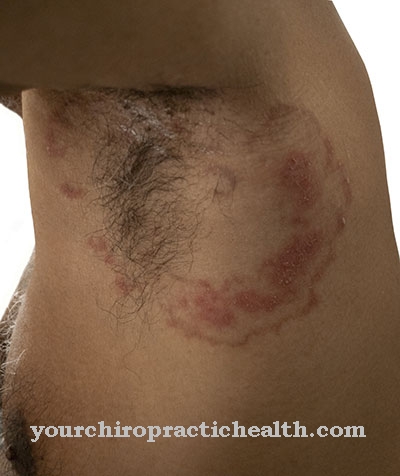Anyone who feels the symptoms of a light-sensitive, reddened, painful and watery eye could possibly have one Corneal ulcer (ulcus corneae) Suffer. It is therefore advisable to see an ophthalmologist quickly if these signs occur.
What is a corneal ulcer?

© Alila Medical Media - stock.adobe.com
At a Corneal ulcer there is an increasing melting at the edge of the cornea, which is triggered by infectious. The certain pathogens can penetrate through a superficial injury to the cornea; the result is a reddened and irritated eye.
Since the cornea is extremely important for the ability to see, a corneal ulcer should be treated immediately by an ophthalmologist. Eyesight can be severely impaired by a corneal ulcer, since the refractive power of the cornea is disturbed by such an irregularity.
Due to the sensitive nerve supply to the eye, an injury to the cornea can usually be noticed through pain and uncontrollable tearing. A corneal ulcer can eventually develop due to a corneal injury.
causes
The cause of one Corneal ulcer is due to an infection caused by a certain pathogen.
Certain factors can promote the development of a corneal ulcer, such as dry eyes, frequent wearing of soft contact lenses and existing injuries to the cornea on its surface.
Inflammation of the eye sac or cornea can also be beneficial. Additional risk factors are diabetes mellitus, rheumatic diseases or old age.
Symptons, ailments & signs
The symptoms of a corneal ulcer can develop acutely and worsen dramatically. Generally they are similar to those of corneal inflammation. The most striking here are strong and persistent eye pain. Another typical sign is a noticeable reddening of the affected eye. Those affected also complain of significantly impaired vision.
There is also increased sensitivity to light. The symptoms increase when the person concerned looks directly into the light. The appearance of a foreign body sensation in the eye is also noticeable in a corneal ulcer. Most patients also complain of impaired vision. The affected person can also no longer control the flow of tears. The eye keeps watering. In many cases, a corneal ulcer also results in a significantly swollen conjunctiva
The disease can also be easily seen directly on the cornea. So the ulcer itself appears as a gray-white opacity. The center is thinned and the edges are raised. If they are not treated, the symptoms mentioned will usually worsen significantly on their own. As an extreme consequence, complete blindness of the eye at this stage can also be a sign of the corneal ulcer.
Diagnosis & course
The diagnosis in one Corneal ulcer is not difficult for the specialist, based on the patient's medical history, among other things. If the above-mentioned factors are also added, this can indicate corneal damage.
The corneal ulcer can be clearly recognized by means of an examination with a so-called slit lamp, which the doctor carries out if it is suspected. The tear ducts are also often flushed to clean them or to prevent them from narrowing. In order to be able to prepare and adapt the subsequent therapy, the ophthalmologist takes a swab from the conjunctiva and the corneal ulcer.
This is how the responsible pathogens for the corneal ulcer are determined. In order to avoid a bad course, the corneal ulcer should be examined or treated immediately after the symptoms appear. Eyesight can deteriorate so much within a few hours that a kind of scar remains on the cornea after the therapy. This can permanently impair vision. The most fatal course would be blindness of the affected eye.
Complications
A corneal ulcer can cause an infection in the eye, which of course can also cause various complications. At the first signs of worsening, a doctor should definitely be consulted so that any consequential damage can be recognized early and treated accordingly. An infection usually manifests itself in a severely reddened eye.
A significantly increased flow of tears can also be an indication of an infection. Affected people should consult a doctor directly in such a case so that the inflammation can be effectively and quickly alleviated with appropriate medication. However, if medical treatment is dispensed with at this point, there is a risk of a significant deterioration.
In particularly bad cases, pus can even develop, so that a doctor should be consulted immediately at the latest. Otherwise, the cornea can be permanently damaged, with permanent consequential damage to the eye. The following applies: A corneal ulcer should by no means be taken lightly.
If this clinical picture remains without any treatment, there is a risk of serious complications. If you want to avoid these complications at an early stage, you should consult a doctor at the first signs of inflammation. With the right medication, an eye infection can be treated effectively and quickly.
When should you go to the doctor?
If symptoms such as eye pain, sensitivity to light, and red eyes are noticed, the cause may be a corneal ulcer. A doctor's visit is indicated if the symptoms appear suddenly and persist for more than two to three days. If there are additional symptoms, the ophthalmologist must be consulted on the same day. A corneal ulcer can get so bad within a few hours that a scar will remain after treatment.
To avoid scarring or even blindness, the disease must be investigated and treated immediately. People who have had dry eyes for a long time or who wear soft contact lenses are particularly prone to corneal ulcer. People with rheumatic diseases or diabetes mellitus also belong to the risk groups and should see a doctor immediately if the symptoms mentioned. If pus develops, eyesight suddenly deteriorates, or pain occurs, the person should be taken to hospital. Children should be taken to the pediatrician if there are signs of a corneal ulcer.
Doctors & therapists in your area
Treatment & Therapy
The therapy of the Corneal ulcer is mainly carried out locally; constricted tear ducts are flushed directly. Anyone who wears contact lenses should definitely refrain from wearing them until they have completely healed.
To combat the pathogens, antibiotic drops are prescribed. If the middle skin of the eye is inflamed at the same time, treatment with antibiotics in tablet form must be carried out. If the corneal ulcer is very advanced or the cornea is already perforated, an operation is carried out in which the cornea is transplanted. It is possible that this will be followed by further operations if the transplanted cornea cannot heal directly.
If there is still no improvement after conservative therapy with eye drops and tablets, an operation may be necessary. Such treatment for a corneal ulcer sometimes extends for several weeks. In any case, the transplantation must be carried out before the pathogens can migrate to the edge of the cornea so that they cannot infect the new cornea again.
If the corneal ulcer is rheumatic, surgery is often required. However, there is a risk of new rheumatic ulcers forming. If a scar remains after conservative therapy that severely affects vision, a corneal transplant can also be performed.
You can find your medication here
➔ Medicines for eye infectionsOutlook & forecast
The prognosis of the corneal ulcer is assessed according to the time of possible initiation of treatment. In acute situations there can be a significant increase in symptoms within a few hours, as the ulcer continues to grow unabated. The later it is possible to start therapy, the more difficult the further course of the disease and optimal healing prospects are.
In severe cases, the patient is threatened with permanent impairment of vision or blindness. This is especially true if the patient does not seek medical care or the therapy carried out remains unsuccessful. In an emergency operation, a corneal transplant must be carried out if possible so that there is a chance of improving eyesight. Alternatively, the patient is at risk of going blind.
If there is additional inflammation of the inside of the eye, a significant delay in the healing process can be expected. The pathogens have already spread in the eye and must be treated. If drug treatment takes place as soon as possible, a faster regression of symptoms can be observed in most cases. The germs are killed and transported out of the organism. The ulcer recedes completely and recovery is possible.
If there is damage to the retina, this can lead to permanent clouding of vision or permanent impairment of natural vision.
prevention
The Corneal ulcer can be prevented if damage to the cornea is avoided, for example through early treatment of insufficient eyelid closure. In addition, careful hygiene when wearing contact lenses is advisable so that no germs can form there; both on the lenses and in the storage boxes. The contact lenses should generally not be worn too long a day and should definitely be taken out before going to sleep.
Aftercare
With a corneal ulcer, in most cases the patient has very few measures and options for direct follow-up care. The main priority for this disease is prompt treatment to prevent the ulcer from spreading further in the person's body. The earlier the disease is recognized by a doctor, the better the further course is usually, so that the patient should see a doctor as soon as the first symptoms of the disease are seen.
Whether this disease will lead to a reduced life expectancy cannot generally be predicted. In the worst case, the affected person will go blind. If the treatment of the disease is carried out by taking antibiotics, the person affected should ensure that the medication is taken regularly and that the dosage is correct.
It should also be noted that antibiotics should not be taken together with alcohol. Eye drops should also be used regularly. In severe cases, however, surgery is necessary to alleviate the symptoms. After such an operation, the area around the eyes should be particularly well protected. The further course depends very much on the time of diagnosis, so that no general prediction can be made.
You can do that yourself
A corneal ulcer can be prevented by various hygiene measures. During treatment, however, the patient is always dependent on treatment by a doctor in order to avoid complete loss of vision.
If the patient is dependent on contact lenses, they should always be disinfected. Even before going to sleep, it is advisable to take out your contact lenses and not hold them by your eyes. The treatment of the corneal ulcer is usually done with the help of eye drops or antibiotics. The affected person must ensure that they are taken regularly and possibly refrain from other drugs if these would interfere with the effectiveness of the antibiotics. However, advice from a doctor is advisable. Under no circumstances should medication be discontinued or changed without consulting a doctor.
A corneal ulcer can also lead to blindness. In this case, psychological complaints and depression must be prevented. The help of friends and acquaintances can make the patient's everyday life much easier and also prevent psychological upsets. Discussions with other sick people are also helpful. Corneal transplantation can prevent blindness in severe cases.




.jpg)



















.jpg)


